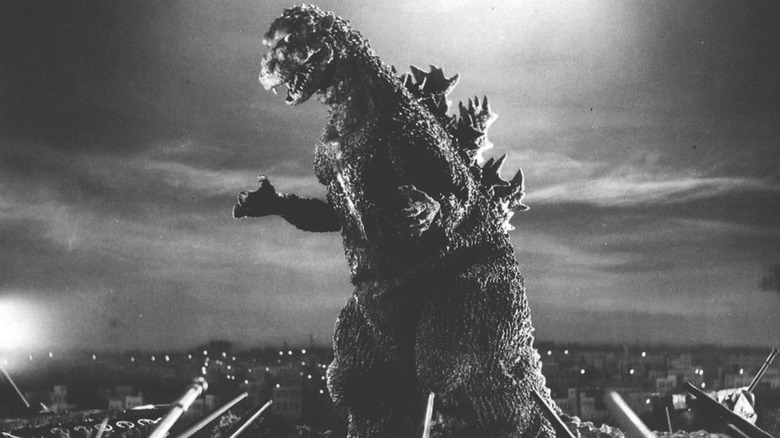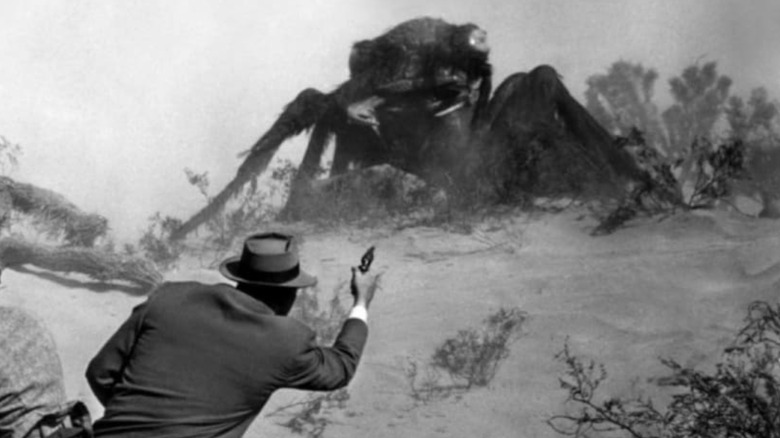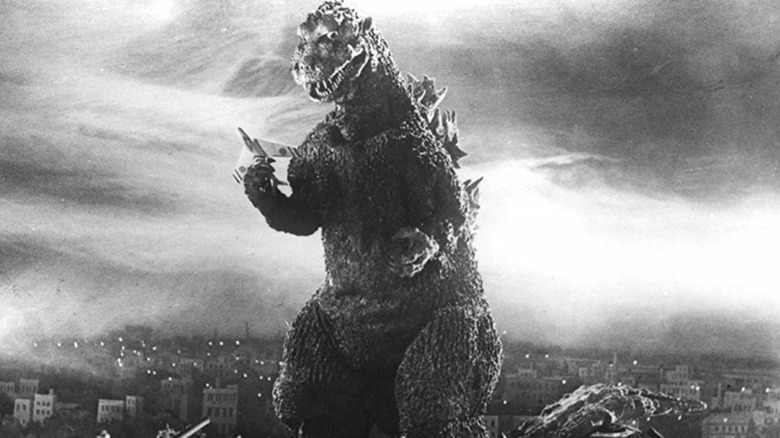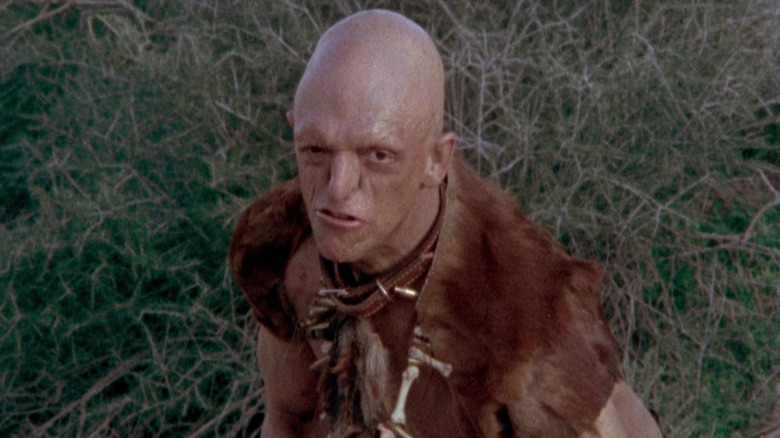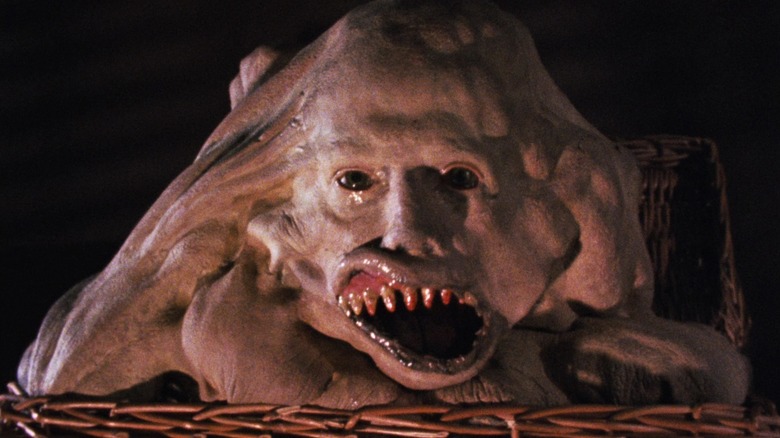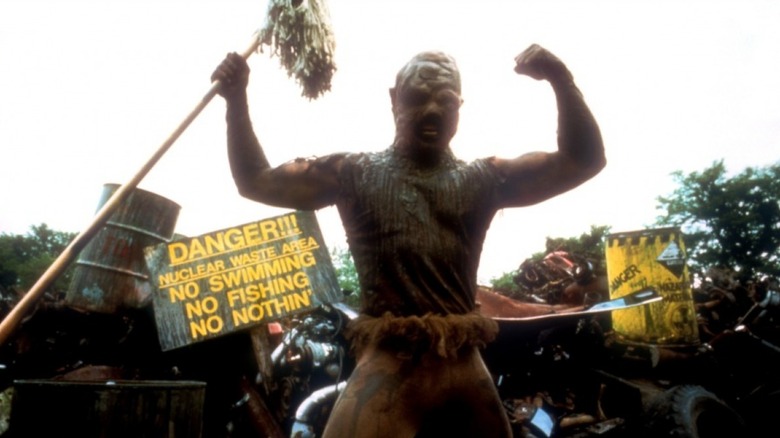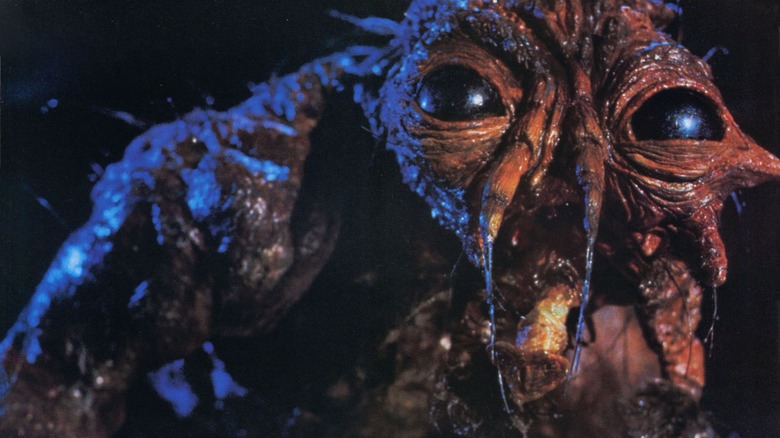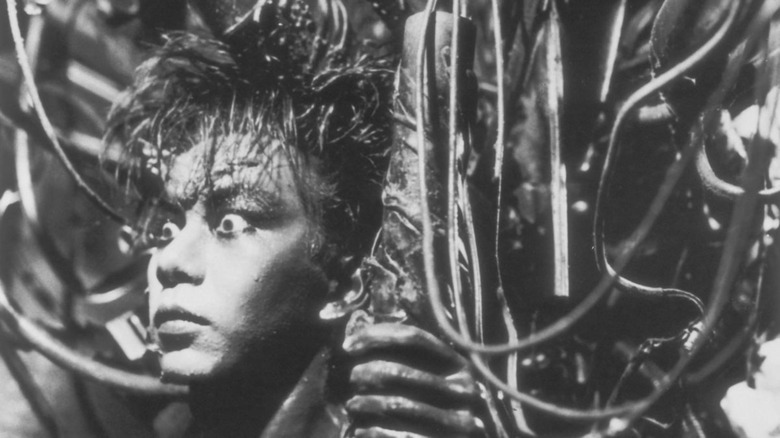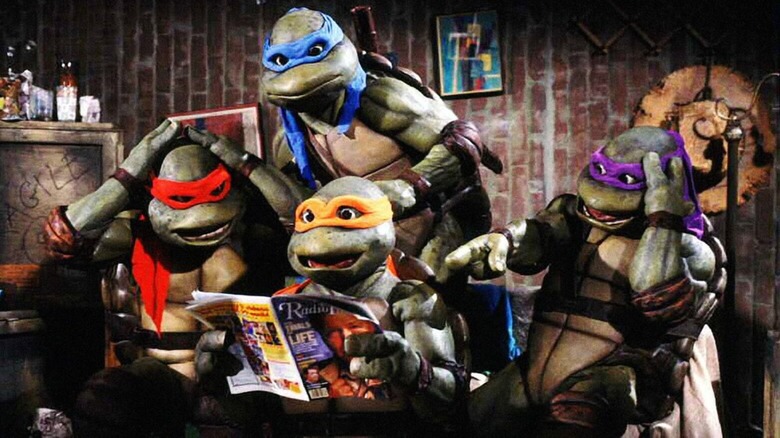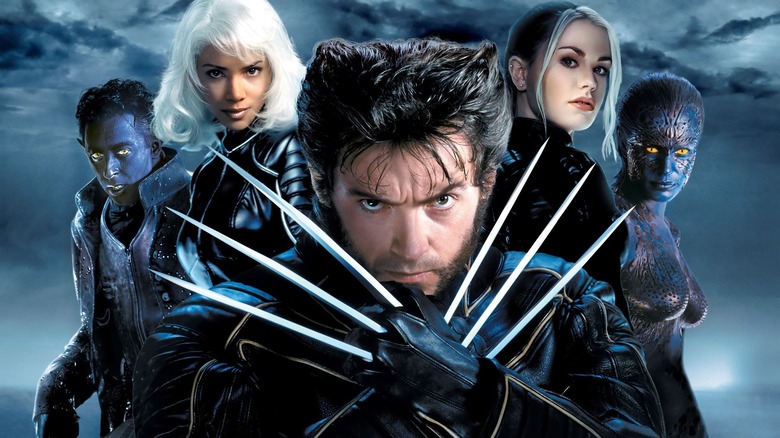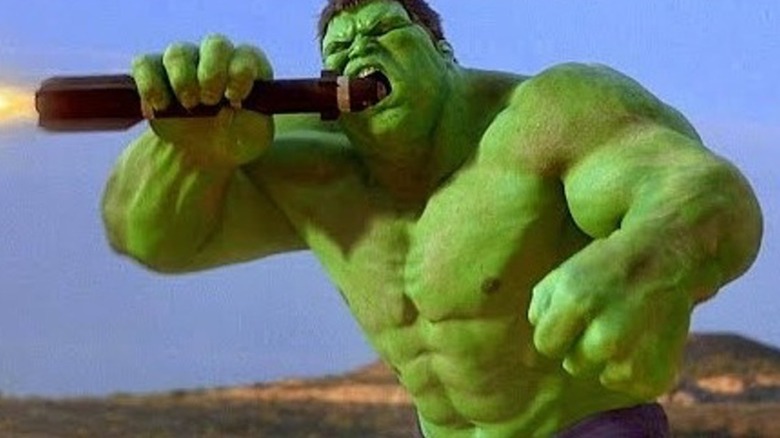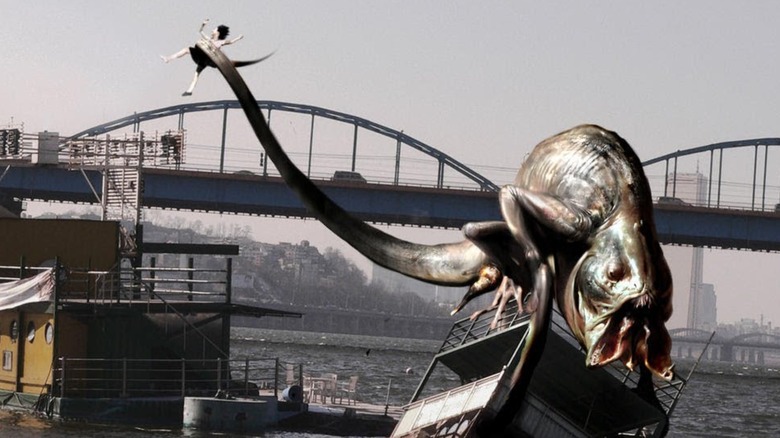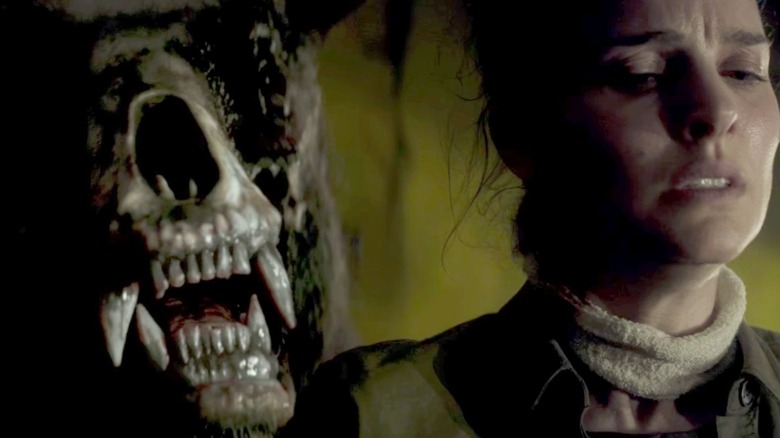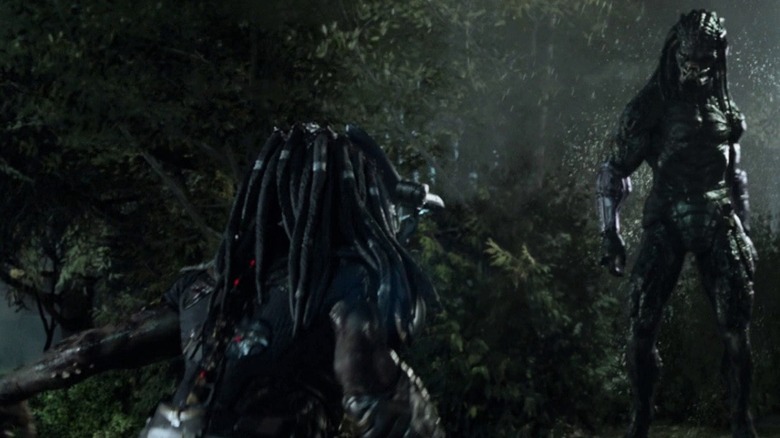The Best Movie Mutations We've Ever Seen
Since the 1950s era of the "nuclear monsters," mutants of various stripes and sizes have been a persistent element of the big screen. Reflecting concern over the potential destructiveness of nuclear power and radiation, U.S. cinema emerged with visions of massive ants in 1954's "Them!," giant tarantulas in 1955's "Tarantula!," and a massive praying mantis in 1957's "The Deadly Mantis." In Japan, 1954's "Godzilla" began the long tradition of kaiju films that persists in popularity to this day.
As time went on, other kinds of movie mutants would emerge, spawned from radiation, chemicals, natural mutations in their genetic code, or even as accidental by-products of ordinary experimentation. Some of them are hybrids, some are extraterrestrial threats, and some are just like us but with way more power. Here are the very best mutants and mutations ever to grace the big screen. Each has proven influential and innovative, standing the test of time.
Them!
1954 is one of the most important years in the history of monster movies. "The Creature from the Black Lagoon" gave us the Gill-man, one of the best designs of all time and the last great new Universal monster. Fueled by grave concerns over nuclear power, "Godzilla" emerged as the first of the kaiju films and launched the most popular kaiju franchise of all time. Fears over the dangers of nuclear power also fueled a number of American "nuclear monster" films, and 1954 saw the greatest in "Them!" The movie sees a town plagued by irradiated, giant nuclear ants.
The ants mutated to their massive size due to radiation, with each one as big as a vehicle. When two young queens move on, apparently to start new colonies, they have to be stopped at all costs. "Them!" boasts surprisingly great effects for 1954, the performances work, and the stakes are high. It's most importantly the pinnacle of the American "nuclear monster" films. It shows the extent of fear people had over the potential consequences of nuclear technology and its possible effects on the natural world. In "Them," these fears are expressed better than in many other U.S. films, resulting in some of the greatest mutants to hit the silver screen.
Godzilla
The most important spot on this list is an easy choice. Ishirō Honda changed the cinematic landscape in 1954 with "Godzilla," about the titular giant monster that suddenly appears on Japanese shores to cause terrifying destruction. The film pioneered the "suitmation" SFX technique, launched a franchise around Godzilla (the most influential and popular kaiju of all time), and is a straightforward masterpiece of cinema with sheer horror substituting for the silly-fun tone of future "Godzilla" entries.
In the film, Godzilla is an ancient sea creature who was awoken and mutated by hydrogen bomb testing. The film itself stems from Japanese concern with nuclear bombs and nuclear testing (even his skin is designed to look like the keloid scars of Hiroshima victims), using genre tropes to express deeply political fears. What's more, his nature of being a massive, horrific mutation machine is more recently underscored in 2016's epic "Shin Godzilla." Much more like the 1954 classic than the subsequent monster-battle entries, the 2016 film gives Godzilla a similar origin story but showcases his ability to quickly evolve into a variety of forms before his reign of terror is stopped. Simply put, Godzilla is one of the greatest movie monsters in history, and the best mutated monster of all time.
The Hills Have Eyes
Wes Craven's 1977 classic "The Hills Have Eyes" sees the Carter family traveling towards Los Angeles. As they make their way through Nevada, gas station owner Fred (John Steadman) warns them to stay on the main road, but the unfortunate family crash off a desert road. As they travel through the wilderness, they encounter a clan of mutated hill people lead by Papa Jupiter (James Whitworth). We come to find out that Jupiter is Fred's son who murdered his own sister, and he was attacked by Fred and left to die in the hills. While there, he was able to procreate, producing a clan of three sons and a daughter who survive by preying on and eating unfortunate passersby.
The film uses fear of mutation to create an otherworldly, alien set of menaces out of the villainous antagonists. Amplifying this otherness is their predatory cannibalism, creating a sense of threat. "The Hills Have Eyes" is a classic mutant-filled exploitation film of the era, and one that went on to influence a number of subsequent movies.
Basket Case
Frank Henenlotter's 1982 "Basket Case" follows Duane Bradley, a gentleman who checks into a cheap New York City hotel with a locked, heavy wicker basket. We discover that the basket contains a living, mutated, formerly conjoined twin brother named Belial. The pair are each traumatized from the ordeal in their own ways: Duane wants the world to show greater understanding towards Belial, while the latter resents being forcibly separated from the former. Their plan is to get vengeance against the doctors who separated them, but tension between the two emerges when Duane befriends a nurse named Sharon, and Belial, jealous, kills her, breaking the brothers' unbreakable bond.
It's a low-budget horror comedy that launched a trilogy, and a cult classic to boot. Due to Belial's mutation, he has sharp teeth and claws and unusual strength despite being misshapen, small, and confined to a basket. Out of the wave of the 1980s' use of mutants as a periodic horror plot element, the film still shines as one of the most memorable.
Toxie
Troma Entertainment has a long legacy of conceptually innovative, low-budget independent films of the horror and horror-comedy genres, with everything from "Class of Nuke 'Em High" and "Surf Nazis Must Die" to Shakespeare parodies like "Tromeo and Juliet." One of its best film series began with 1984's "The Toxic Avenger." It follows a lowly janitor, Melvin Junko III, who is abused by the local town bullies. One particularly cruel day results in Melvin becoming submerged in toxic chemicals and set aflame, after which he emerges horribly disfigured but with enhanced strength. He goes on to perform heroic activities as the Toxic Avenger.
The film had small beginnings as a long-running midnight movie showing at New York's Bleecker Street Cinema, gradually gathering a cult following as a clever send-up of the superhero genre. It became so successful, in fact, that it resulted in a five-film franchise, a children's animated TV show, a Sega Genesis video game, and even a recent announcement that Legendary Entertainment will be remaking it in a partnership with Troma. It's brash, funny, and violent, but altogether, it's fun. Most importantly, good ol' Toxie is one of the more memorable of the low-budget Troma creations and an intriguing example of chemicals causing a physical mutation that obviously struck a chord with many.
Brundlefly
David Cronenberg's career as the master of body horror effectively guarantees him some high placement on this list. "Rabid," "The Brood," and "Videodrome" could easily fight for a spot, but "The Fly" (a remake of the 1958 version) is an absolute masterpiece. The film follows scientist Seth Brundle as he works on his invention — a teleportation device that allows instantaneous transportation between two pods. Eventually, like eccentric movie scientists are known to do, he uses the machine on himself. What Seth doesn't know is that a fly entered the teleport machine, and on his reconstitution in the second machine, his DNA was merged with said fly.
We watch Seth progressively (and horrifically) turn into a fly-man hybrid over the course of the movie in what's one of the greatest movie mutations of all time. It's a masterful film, and as Seth becomes less and less human, the audience feels more for him and the pain of his love interest, science journalist Veronica Quaife. Overall, the film is notable for having some of the greatest practical creature FX of all time, having one of the longest and most extensive mutations onscreen, and for adding so much pathos that we can't help but feel for the monster even at its most monstrous.
Salaryman / The Metal Fetishist
Shinya Tsukamoto's 1989 "Tetsuo: The Iron Man" follows the villainous metal fetishist Yatsu, who obsessively puts metal into his body until the point where he progressively mutates into a machine-man hybrid. He starts to torment a local salaryman with visions of metal and progressively turning him into a man-machine hybrid as well. Towards the end of the first film, the two mutating beings fight, causing them to turn into a single fused being that wants to turn the entire world to metal.
The film was followed by two more, "Tetsuo 2: Body Hammer" and "Tetsuo: The Bullet Man," which continue the odd metal mutation legacy of the original. They're incredibly unique films, sporting complex narratives, often chaotic and surreal elements, and a legacy of truly unique body horror. The mutations themselves are shocking, incredible, and conceptually complex — and where else can you see a fight between two beings that become a grotesque sentient fusion of man and machine?
Teenage Mutant Ninja Turtles
The Teenage Mutant Ninja Turtles characters first debuted in Eastman and Laird's "Teenage Mutant Ninja Turtles" comic books in May 1984. Four turtles became exposed to a chemical mutagen that mutated them into intelligent humanoids, as it did to a rat who became their sensei, Master Splinter. The four trained turtles, Leonardo, Michelangelo, Raphael, and Donatello, fight the evil ninjas of the Foot Clan (lead by the Shredder and Krang in various media) and other mutated villains with the help of various allies.
While the Turtles' first onscreen adaptation was the 1987 animated TV series "Teenage Mutant Ninja Turtles," their big screen leap was in 1990's "Teenage Mutant Ninja Turtles." It was followed by two more films in 1991 and 1993, and the franchise saw a big-screen reboot in 2014 and its sequel in 2016. While the comics were relatively popular, the animated series and subsequent films made the Ninja Turtles some of the most popular characters of the time, as well as some of the most iconic mutants in film history.
Marvel's mutants
No list of movie mutants would be complete without mentioning the film appearances of the various mutants that populate Marvel's "X-Men" stories. Each of Marvel's mutants (called Homo superior or Homo mutatis) were born with the X-Gene in their DNA, with puberty and possibly trauma triggering its activation. Once the gene activates, there are many potential physical changes it can produce, from physical transformations (like Nightcrawler or Angel) to additional bodily features (like Wolverine's claws) to a wide array of powers. At its most extreme, for example, you'd find the vastly powerful David Haller (aka Legion), whose mind was fractured by trauma such that he has potentially hundreds of personalities, each with its own distinct power. Legion's power is so great that some of his personalities can even alter reality and control time.
In short, the mutations of the Marvel universe are incredibly varied and can produce some unbelievable powers. Many of the greatest Marvel mutants have made it to the big screen with the "X-Men" franchise (beginning in 2000) and "Deadpool" films, among others, and these characters remain some of Marvel's most beloved.
The Hulk
It's impossible to make a list of excellent film mutations without accounting for superhero properties, and with so many to choose from, it could easily fill up its own sizable list. Whether astonishing, incredible, or immortal, the Hulk debuted in May 1962's "The Incredible Hulk #1" before the character later took off in "Tales to Astonish." The Hulk started out as Dr. Bruce Banner, a brilliant scientist who became exposed to gamma radiation. The result of the exposure is that Banner had two selves, his Banner personality and the Hulk, a massive, gray or green monstrosity that he turns into when enraged or endangered.
In his transformed state, Hulk becomes stronger as he get angrier, in effect having nearly infinite strength as well as having a healing rate that renders him nigh-indestructible. He made his big-screen debut in 2003's Ang Lee film "Hulk," which introduced Hulk/Banner as he attempts to escape General Thaddeus Ross and other threats. The Hulk is one of the most important mutations in the comic world, and while 2003's "Hulk" was made before the Marvel Cinematic Universe emerged with its overarching vision, it is an excellent introduction to the character. Altogether, it's a stunning mutation and one of Marvel's most memorable.
Gwoemul
"The Host," Bong Joon-ho's 2006 masterpiece, follows Park Gang-du, the irresponsible co-owner of a small snack bar beside the Han River. Years after an American military pathologist orders the dumping of 200 bottles of formaldehyde down a drain that flows into the river, a massive, misshapen monster emerges and rampages through the nearby crowd. It kills many and takes Park's daughter, and it's up to the family to find and recover her in the face of bureaucratic government ineptitude.
The creature, called Gwoemul, is an excellently designed mutated form of aquatic life. The formaldehyde caused its mutation, and it became a large, fast, strong beast with an equally strong appetite for human prey. The creature itself was inspired by a real-life incident in 2000 when an American morgue worker dumped a large amount of formaldehyde into the same river, and the film demonstrates the local distrust of U.S. military presence in South Korea. Ultimately "The Host" is a smart, well-performed and directed monster movie that's packed with meaning and uses mutation to spark a story with a large social punch.
Mutant Bear
2018's "Annihilation" follows a mysterious government team's journey into the Shimmer, an ever-growing field (emanating from a mysterious entity at its center) in which all signals, matter, and DNA mutate, shift, and change. Its motives and origins are mysterious, but it results in a host of physiological changes to everything within its territory — plants, animals, and people all start to mutate and pull the DNA of other entities into their own. In the film (based on Jeff VanderMeer's novel of the same name), this produces a host of complex mutations — people turned into plant life, an alligator with shark-like teeth, and more.
The most shocking mutation, however, is a mutated bear — besides its massive frame, its face features partially exposed skull with attributes of a human skull inside its own. If that isn't fearsome enough, it has the ability to reproduce the screams of its human victims, drawing the government team towards it and into danger. If the Shimmer is a mutation engine, the Mutant Bear shows the awesome and nightmarish effects that such a power can produce.
The Upgrade and Fugitive Predators
2018's "The Predator" sees a conflict among two very different Yautja as one brings a human-sized advanced Predator suit to Earth (dubbed Predator Killer armor), with the other in hot pursuit. It isn't the first time we've seen Yautja fight each other on the big screen, but what sets this story apart is that we discover that these Yautja are genetic hybrids.
The first, the Fugitive Predator, is genetically part human. The second Predator is dubbed the Upgrade Predator and is notably much larger, with a rough, regenerating exoskeleton among other genetic improvements. The film adds a lot to the Predator mythos, establishing that the species may not be content with merely becoming more skilled hunters but rather may try to become a stronger, modified variant of themselves with uniquely chosen adaptations. What is most interesting is that it shows intentional strategic self-mutations (a rarity on the big screen) as Yautja splice their DNA with that of other species. It isn't known how this is accomplished or how widely the Yautja practice it, but it allows powerful mutations that dramatically enhance Predator abilities.
